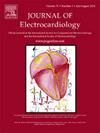下肋间隙放置V1引导传导系统起搏导联植入物
IF 1.3
4区 医学
Q3 CARDIAC & CARDIOVASCULAR SYSTEMS
引用次数: 0
摘要
实现传导系统区域起搏(CSP)的初始判据是导联V1中终端R波的存在。使用不同的配置来确定,当CSP导联放置在中间隔或前间隔较深的位置时,将V1放置在右下肋间隙会导致末端R波的振幅更大。V1端R波易于识别将更加实用,并有可能减少左束分支区域起搏(LBBaP)尝试的位置数量,从而加快手术速度并减少潜在的并发症,如室间隔穿孔。本文章由计算机程序翻译,如有差异,请以英文原文为准。
Lower intercostal space V1 placement to guide conduction system pacing lead implants
The initial criterion to achieve conduction system area pacing (CSP) is the presence of a terminal R wave in lead V1. Different configurations were used to determine that placing V1 in lower right intercostal spaces results in a greater amplitude of the terminal R waves when the CSP lead is placed deep in the mid-septal or antero-septal locations. Easily identified terminal R wave in V1 will be more practical and potentially reduce the number of sites attempted for left bundle branch area pacing (LBBaP), resulting in faster procedures and reducing potential complications such as septal perforation.
求助全文
通过发布文献求助,成功后即可免费获取论文全文。
去求助
来源期刊

Journal of electrocardiology
医学-心血管系统
CiteScore
2.70
自引率
7.70%
发文量
152
审稿时长
38 days
期刊介绍:
The Journal of Electrocardiology is devoted exclusively to clinical and experimental studies of the electrical activities of the heart. It seeks to contribute significantly to the accuracy of diagnosis and prognosis and the effective treatment, prevention, or delay of heart disease. Editorial contents include electrocardiography, vectorcardiography, arrhythmias, membrane action potential, cardiac pacing, monitoring defibrillation, instrumentation, drug effects, and computer applications.
 求助内容:
求助内容: 应助结果提醒方式:
应助结果提醒方式:


